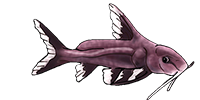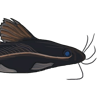| Scientific Name | Trachycorystes trachycorystes (Valenciennes, 1840) |
| Common Names | Iron Head Driftwood Catfish Black Driftwood Catfish, Black Woodcat |
| Type Locality | Amazon River basin, Brazil. |
| Synonym(s) | Auchenipterus obscurus, Auchenipterus trachycorystes, Trachycorystes obscurus, Trachycorystes typus |
| Etymology | Trachycorystes: From the Greek trachys, meaning rough and korystes, meaning one armed with a helmet; in reference to the rugose cranial shield. |
| Size | 350mm or 13.8" SL. Find near, nearer or same sized spp. |
| Identification | This Auchenipterid looks slender. It is the same colour all over (usually black) including the belly. Some report their fish having a brown colour, perhaps this is a different species. Even more striking is the protruding lower jaw that gives this species identity easily away. |
| Sexing | Males have a genital papilla and do not grow as large as females. Males are also reported to develop thickened barbels and/or larger dorsal spines. |
| General Remarks | Of the handful of Trachycorystes that are known to science,Trachycorystes trachycorystes is the usual one that is exported albeit on an irregular basis. See also K & B Teats, TFH Dec. 1986 pages 30-37. |
| Distribution | South America: Amazon River basin. Amazon (click on these areas to find other species found there) Amazon, Lower Amazon, Nhamundá (click on these areas to find other species found there) Login to view the map. |
| IUCN Red List Category | Least Concern , range map and more is available on the IUCN species page. Last assessed 2020. |
| pH | 6.4 - 7.0 |
| Temperature | 23.0-29.0°C or 73.4-84.2°F (Show species within this range) |
| Other Parameters | Generally undemanding. |
| Feeding | Everything that fits its (huge) mouth. Preferably live food and plenty of it. Larger frozen foods will also be eaten. No daphnia and such! Happily eats prepared foods too. User data. |
| Furniture | Large pieces of driftwood as hiding places. Yet these fish also need swimming space for their nocturnal escapades. Make sure tank covers are secured for this species may jump in the beginning. |
| Compatibility | An aggressive fish that requires a species tank with plenty of refuges, as this species will also attack its own congeners when it feels like it (see Reference; TFH article by K & B Teats). Don't put smaller fish in the same tank, not even fish that may be able to defend themselves well: in the end, they will be killed. |
| Suggested Tankmates | Only very large fish; certainly avoid slow moving species like (full grown) angelfish and fishes that would compete for refuge with this brute. |
| Breeding | Unreported. |
| Breeding Reports | There is no breeding report. |
| Reference | Histoire naturelle des poissons v. 15, pp 214, Pl. 437. |
| Registered Keepers | There are 14 registered keepers, view all "my cats" data. |
| Wishlists | Love this species? Click the heart to add it to your wish list. There are 4 wishes to keep this species, see who wants what. |
| Spotters | Spotted this species somewhere? Click the binoculars! There are 13 records of this fish being seen, view them all. |
| Forum BBCode | |
| Search for T. trachycorystes | |
| Look up T. trachycorystes on AquaticRepublic.com | |
 | Look up T. trachycorystes on Fishbase |
 | Look up T. trachycorystes on Encyclopedia of Life |
 | Look up T. trachycorystes on Global Biodiversity Information Facility |
| LFS label creator ARN ref:1.22.251.965 | |
| Last Update | 2025 Jan 02 01:39 (species record created: 2005 Nov 23 00:00) |





/siluriformes/auchenipteridae/trachycorystes/trachycorystes/1.jpg)

/siluriformes/auchenipteridae/trachycorystes/trachycorystes/3.jpg)
/siluriformes/auchenipteridae/trachycorystes/trachycorystes/4.jpg)
/siluriformes/auchenipteridae/trachycorystes/trachycorystes/5.jpg)
/siluriformes/auchenipteridae/trachycorystes/trachycorystes/6.jpg)
/siluriformes/auchenipteridae/trachycorystes/trachycorystes/7.jpg)
/siluriformes/auchenipteridae/trachycorystes/trachycorystes/8.jpg)
/siluriformes/auchenipteridae/trachycorystes/trachycorystes/9.jpg)
/siluriformes/auchenipteridae/trachycorystes/trachycorystes/10.jpg)
/siluriformes/auchenipteridae/trachycorystes/trachycorystes/11.jpg)
/siluriformes/auchenipteridae/trachycorystes/trachycorystes/12.jpg)
/siluriformes/auchenipteridae/trachycorystes/trachycorystes/13.jpg)
/siluriformes/auchenipteridae/trachycorystes/trachycorystes/14.jpg)